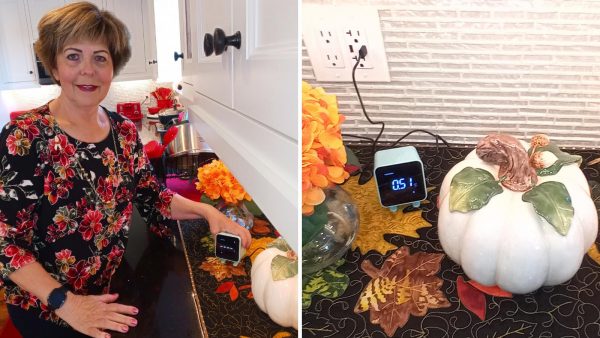Just imagine: you don’t smoke and never have. Still, your doctor gives you the terrible news that you have lung cancer.
That’s what happened to Kerri Robbins, a resident of Lehi, Utah. After receiving this diagnosis, she has not only been fighting against her cancer but also using her shocking experience to raise awareness of radon — the deadly gas that tried to kill her.
Kerri Robbins’ story
“A year ago, on August 30th, I was diagnosed with stage four non-smoking lung cancer,” Robbins says. “About three months prior, I had gotten up one morning and gotten on my treadmill. All of a sudden, I was gagging and throwing up my water, but it hadn’t gone down the wrong windpipe. Something had happened.”
She went downstairs, where her husband Ron was making breakfast. When she told him what had happened, they went to the ER. After extensive testing, an MRI showed something they found hard to believe due to their healthy lifestyle: Robbins had a brain tumor.
The next step was to visit the oncologist, whose Positron Emission Tomography (PET) scan showed a small spot on Robbins’ left lung. “When the oncologist told me I had stage four non-smoking lung cancer, you could have knocked me over with a feather,” Robbins says. “I didn’t have any symptoms. I didn’t have any signs.”
According to Medical News Today, “Stage four is the most severe stage of cancer… It conveys that the cancer has metastasized — spread to distant areas of the body.” While not necessarily terminal, this advanced stage of cancer does signal significant risk to the patient’s life.
When Robbins went to see a thoracic cancer specialist in Salt Lake City, the reason for her illness became apparent. “The first thing he asked me was, ‘Do you smoke?’ And I said, ‘No,’” she remembers. “He goes, ‘Have you had home tested for radon?’ And I go, ‘Didn’t know I needed to.’”
Radon: A major source of lung cancer
Unfortunately, radon is present in far too many homes. According to a recent report from the American Lung Association (ALA), dangerous levels of radon are found in approximately 3.1 percent of residences in Louisiana, which boasts the best performance among all states in the country.
While the percentages of homes with radon in the range of 18 percent to 28.5 percent might initially seem high, the American Lung Association (ALA) categorizes this as the “average” tier in their findings. Oregon represents the lower end with 18 percent while West Virginia tops this ‘average’ tier with 28.5 percent. Other states falling within this range include Arkansas (20.1 percent), Maryland (21.4 percent), Rhode Island (21.4 percent), Georgia (21.5 percent), Vermont (21.7 percent), Massachusetts (21.8 percent), Michigan (22.8 percent), New Mexico (24.8 percent), Virginia (25.2 percent), Connecticut (26.8 percent) and Tennessee (26.8 percent).
States that fall into ALA’s “above average” range include:
- Missouri (31.0 percent)
- Idaho (33.3 percent)
- Illinois (33.5 percent)
- Kansas (34.5 percent)
- New Hampshire (35.3 percent)
- Maine (36.5 percent)
- Kentucky (36.9 percent)
- Pennsylvania (39.1 percent)
- Indiana (40.2 percent)
- Utah (40.6 percent)
- Minnesota (41.7 percent)
- Wyoming (44.5 percent)
However, these states don’t even have the worst rates of exposure. Here are the ones that do:
- Montana (45.6 percent)
- Colorado (46.1 percent)
- Wisconsin (46.4 percent)
- Ohio (48.8 percent)
- Nebraska (55.8 percent)
- Iowa (57.9 percent)
- North Dakota (58 percent)
- South Dakota (59.8 percent)
Despite these eye-popping statistics, most residents are unaware because this radioactive gas doesn’t have a smell and can’t be seen with the human eye.
When Robbins and her husband had their home tested, the results were devastating. “We were 31.3 pCi /L, which was like I was smoking three packs of cigarettes a day,” she says. The US Environmental Protection Agency considers any exposure to radon unsafe but recommends homeowners consider mitigation for any buildings with 4 pCi/L or more
“I was so mad,” Robbins says. “How come I didn’t know about radon?”
The truth, however, is that most Americans don’t know of their exposure to radon. According to one survey, 60 percent of respondents were unsure or didn’t know if there was radon in their home, and 57 percent admitted to not monitoring for radon.
Radon protection requires constant monitoring
At first, Robbins and her husband feared mitigating their home for radon would cost $4,000 to $5,000, but were pleased when the final bill came to $1,500. “That’s a lot cheaper than cancer,” Robbins remarks.
While radon has since been purged from Robbins’ home, she understands that this invisible, odorless gas can find new ways to infiltrate at any time. “We still don’t know if we’re really that safe unless we have continuous monitoring,” she explains. That’s why she and her husband monitor their radon levels continuously with an EcoBlu radon monitor from Ecosense, which reports live results every 10 minutes, as well as daily, weekly, monthly, and long-term averages on an easy-to-view digital display.
Protect your family’s health
Radon kills 21,000 Americans per year. As January is National Radon Month, the ALA urges everyone to test their homes for radon and mitigate it if necessary. Fortunately, cost-effective and accurate radon monitors can be easily acquired online and at retailers. Insoo Park, CEO, and founder of Ecosense, emphasized ”By combining early radon detection with continuous monitoring, we have a great chance to significantly decrease both the number of lung cancer cases and associated fatalities. This proactive approach not only addresses the health risks posed by dangerous radon levels in homes but also contributes to a tremendous reduction in medical and social costs. Adopting these relatively straightforward preventive measures can enhance the well-being of our society, ultimately safeguarding lives.”
Don’t leave your family’s health up to chance. Protect it by monitoring your home for radon.
